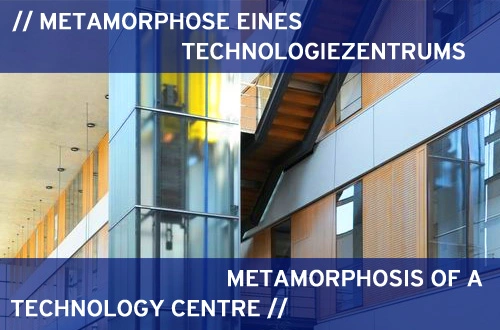Metamorphosis of a Technology Centre
Fifteen years ago, the Environment and Biotechnology Centre opened its doors in the Adlershof Technology Park. Although this initially attracted companies operating above all in the field of environmental analytics, the following years saw this sector undergo cleansing and concentration, also as a consequence of funding cuts. In like measure, however, a growing number of biotech companies started to discover the outstanding laboratory environment the building had to offer. Demand rose, and a second building joined the first. Very soon after, both buildings were completely occupied. According to the Head of the Centre Heidrun Terytze, over seventy companies are operating today in Adlershof in the fields of environmental and biotechnologies.
Why is Adlershof focusing on environmental and biotechnologies?
This focus on particular fields of technology has been accompanying the development of the Science and Technology Park since 1990. It started when successful study groups and projects were transferred from the former GDR Academy of Sciences (AdW) to new institutes and companies at this location. When the alignment to international trends followed, it became clear that scientific findings could be converted quickly into marketable products and services. The up and coming environmental and biotechnologies were undoubtedly a part of this.
What is your recollection of the beginnings?
That was when the location had to be converted during ongoing operations, a requirement that was worded by the then Secretary of State for Economic Affairs. Everything had to be reordered. This evaluation demoted the local AdW institutes to a level below critical. The only institute to remain here, the Adlershof Institute for Applied Chemistry ACA, found it difficult to give life to a new field of technology. Not until later, when new companies were set up in the form of the Humboldt University (HU) Institute for Chemistry in Berlin and the Department of Analytical Chemistry and Reference Materials at the Federal Institute for Materials Research and Testing (BAM), did this field of technology receive the vital boost, and the chain closed between theory, research, and trade.
When did the first major biotech company arrive?
That was Affina-Immuntechnik GmbH at the end of the 1990s. This was followed in 2000 by ASCA GmbH, a disincorporation from ACA and an important provider of custom synthesis services for the pharmaceutical industry.
What were the milestones in this field of technology?
They were the new laboratory buildings: the first in 1997 on Volmerstrasse, and then the second centre in 2006 on Magnusstrasse. We had therefore created the initial infrastructure for environmental and biotechnologies. Equally important was the relocation in 2001 of the HU Institute for Chemistry from the Berlin city centre to Adlershof. This has since attracted students and scientists to the location where they are studying, researching, turning their ideas into products, and founding companies, like e.g. Cyano Biofuels GmbH. Today, this is one of the largest tenants in our Technology Centre.
What role does analytics play at the location?
Analytics is a means to an end. Nowhere else in Germany can such a wide range of analytical methods be found as here in Adlershof with its researchers, method developers, appliance engineers, and sales executives. Short routes make collaboration projects easy. At all events, analytics represents yet another unique feature for the location and a focal discipline on this field of technology in addition to the development of biotech products
and methods, pharmaceutical and medical research, and medical engineering.
by Rico Bigelmann
